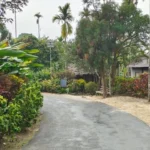
Lumbini, a tranquil town in Nepal, is more than just a historical site; it’s a place of deep spiritual significance and cultural heritage. As the birthplace of Prince Siddhartha Gautama, who later became the Buddha, Lumbini attracts travellers from around the world seeking enlightenment, peace, and a connection to history. Whether you are a history buff, a spiritual seeker, or just an explorer looking for a serene retreat, Limbini offers a journey of life like no other. For first-time visitors, navigating through this UNESCO World Heritage Site can be overwhelming. With countless monasteries, ancient ruins, and sacred landmarks, it’s essential to know which places to prioritize. This Lumbini travel guide by Memorable India takes you through the must-visit attractions, ensuring your trip is both meaningful and unforgettable.
Continue reading to explore the top attractions in Lumbini that will leave you awe-inspiring:
Maya Devi Temple:
At the heart of Lumbini lies the Maya Devi temple, the most religious site in the region. This temple marks the exact spot where Queen Maya Devi gave birth to Prince Siddhartha Gautama under a Sal tree around 563 BC. The atmosphere here is charged with reverence as pilgrims and monks from all over the world gather to offer prayers. Inside the temple, you will find a Marker Stone, which indicates the precise birthplace and an ancient bas-leaf structure of Queen Maya Devi. The temple complex also contains the ruins of an older shrine dating back to the 3rd century BC, believed to have been built by Emperor Ashoka. Stepping inside, you can feel the echoes of history, the whispers of devotion and a profound sense of serenity.
Ashoka Pillar:
Emperor Ashoka, one of India’s greatest rulers and a devoured Buddhist, visited Lumbini in the 3rd century BC and erected the Ashoka Pillar as a mark of respect for the Lord Buddha’s birth and decided to accept Buddhism. Standing tall amidst the lush greenery, the pillars bear inscriptions in Brahmi script, confirming the city’s status as the birthplace of Buddha. This historical landmark is a must-visit attraction in Lumbini, not just for its significance but also for the sense of connection it provides to the ancient past. As you touch the coral stone of the pillar, you can almost hear the echoes of monks chanting from centuries ago, making it a surreal experience.
World Peace Pagoda:
One of the most striking structures in Lumbini is the World Peace Pagoda, a pristine white stupa built by the Japanese Buddhist community. Situated on the Northern side of the city, this magnificent structure stands as the beckon of global harmony and non-violence. A short walk or bicycle ride will lead you to this stunning monument, where a large golden Statue of Buddha rests in a meditative pose. The view from the top of the Stuipa is breathtaking, offering a panoramic vista of the Lumbini landscape. As you stand before the Pagoda, you can’t help but reflect on the universal message of peace that the Buddha preached.
The Monastic Zone:
Lumbini’s Monastic Zone is a fascinating area divided into two sections–East Monastic Zone (home to Theravāda monasteries) and West Monastic Zone (home to Mahāyāna and Vajrayāna monasteries). Walking through this area feels like stepping into a different world, where each monastery tells its own story through intricate architecture and vibrant murals. Some of the must-visit monasteries include:
The Chinese Monastery: A grand, red-and-gold structure reflecting Chinese Buddhist architecture.
The Royal Thai Monastery: A magnificent white marble temple exuding elegance and simplicity.
The Myanmar Golden Temple: Featuring a Burmese-style pagoda and detailed carvings.
The German Monastery (Dharma Swami Maharaja Buddha Vihar): A beautifully painted monastery with detailed frescoes depicting Buddha’s life.
Each monastery offers a different cultural and spiritual experience, making the monastic zone one of the most immersive parts of Lumbini.
Tilaurakot:
A short drive from Lumbini takes you to Tilaurakot, believed to be the site of Kapilavstu, the palace where Prince Siddhartha spent his early years before renouncing worldly pleasures. The ruins of the palace give a glimpse into the luxurious life that the young prince left behind in search of enlightenment. Talking through the exquisite remains, you can almost envision the young Siddhartha standing at the gates, gazing at the world beyond as he contemplates his destiny. For history enthusiasts, Tilaurakot is a treasure trove of ancient artifacts, including poetry and coins from the 6th century BC.
Lumbini Museum:
If you want to delve deeper into the history of Buddhism and Lumbini’s significance, the Lumbini Museum is a must-visit. This museum houses an impressive collection of relics, ancient manuscripts, sculptures, and photographs documenting the evolution of Buddhism. A visit here provides a comprehensive understanding of Lumbini’s role in Buddhist history and its influence across the world.
Crane Sanctuary:
Beyond its spiritual essence, Lumbini is also home to a Crane Sanctuary, a hidden gem for nature lovers. This wetland reserve protects the endangered Sarus Cranes and other migratory birds, offering a perfect escape for those who appreciate wildlife. A morning or evening stroll here amidst the soft chirping of birds and the golden hues of the setting sun brings a different kind of peace that nature alone can provide.
The Great Drigung Kagyu Lotus Stupa:
One of Lumbini’s most striking structures, The Great Drigung Kagyu Lotus Stupa, is an architectural masterpiece showcasing Tibetan Buddhist tradition. With its golden rooftops, colourful paintings, and detailed carvings, the Stupa is a visual delight. Inside, the prayer wheel spins gently as the monks chant in the background, creating a serene atmosphere for contemplation. The Stupa’s design resembling a Lotus flo, symbolizes purity and enlightenment, which are core tenets of Buddhism.
Lumbini is more than just a pilgrimage site; it’s a destination that touches your soul. Whether you come seeking spiritual enlightenment, historical knowledge, or simply a peaceful retreat, this sacred land offers something profound for every traveller. From the revered Maya Devi Temple to the serene Monastic Zone, from the historical Ashoka Pillar to the breathtaking World Peace Pagoda, each site in Lumbini has a story to tell. As you explore, you will find yourself not just discovering places but also unravelling deeper truths about life, peace, and self-awareness.
For first-time visitors, Lumbini is not just a place to see- it’s an experience to feel, a journey to cherish, and a memory that will stay with you forever.

India’s Finest Luxury Retreats: The Ultimate Hotel & Resort Collection
01 Jul 2025
Taj Holidays’ Wildlife Retreats: Where Nature Roars and Luxury Whispers
30 Jun 2025
10 Indian Art Forms You Can Experience During Travel
29 Jun 2025
12 Most Beautiful Villages in India Worth Visiting
28 Jun 2025
6 Best Snorkeling Spots in Andaman for Marine Lovers
27 Jun 2025